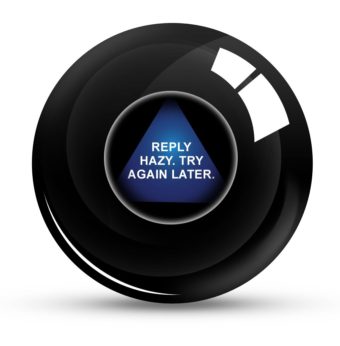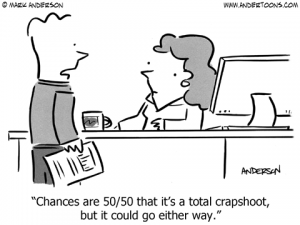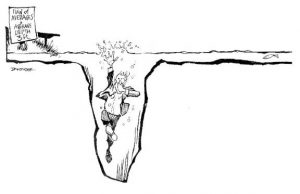Search Waypoint Resources

I’m coining a new term. Avg-holes. It’s pronounced Average-holes. I use the abbreviation, for obvious reasons. It’s the same connotation as the other A-Hole word; only this one applies to people who put the weight of their business’s plan on customer averages.
I recently read an article about the ratings system on movie review websites. You know, the ones that assign a letter grade or percentage grade to movies. Funny, how the same problems that apply to this system apply to diagnosing (rating) B2B customer relationships.
Let’s review this system (pun intended). Each review is classified by either positive or negative (IE Fresh or Rotten). So, for example, if the site collects 350 reviews, and 90 of them fall into the positive category then 90 is 26% of 350, so 26% becomes the movie’s score.
What they don’t tell you, however, is that it’s a flawed system. Allow yours truly to explain. The whole sham is set up so votes fall into either good or bad buckets. It’s slightly more telling than a coin flip. It treats a reviewer who thought the movie was okay but had some problems the same way it treats a reviewer that thought the movie sucked.
Yet other sites are even worse. IMDB and others allow reviewers to rate a movie on a 1 to 10 scale, and then the site averages all scores into a average rating, e.g. 8.1 out of 10. So while Rotten Tomatoes at least tells me the percentage of people that loved a movie, IMDB’s approach tells me that 50% of people rated a moved above 8.1, and 50% rated it lower. How much lower? Who knows, and scores could vary wildly. [Sidebar: readers of this blog know I’ve ranted about this before… https://waypointgroup.org/the-flaw-of-averages-and-the-impact-on-b2b-businesses/)
No different from the way most companies are looking at their business relationships. Most businesses look at the relationships as black or white (or red or green). There is no grey (or yellow). Which is really dumb, because we all know in business (as in life) there are very few absolutes.
We also know that if you have two people that your company works with, and one is happy and the other is not happy, you can’t exactly average them together to create a “neutral” person. The reality is you have 2 people, one happy and one not, that each require a different treatment strategy.
It drives me up a wall when I hear a CEO say something like: “We hold 8.1 customer satisfaction average. We are trying to elevate it to an 8.2.” What the heck does that really mean? You’ve got a number that I just explained is totally bogus and you what to move it up to another, totally bogus number. Hey, I’ve got an idea; let’s use a bogus system to accomplish this. Unfortunately, this is exactly what most of the solutions out there are… bogus.
I see internal feedback stats like “43% of our customers are considered promoters.” News flash, that means 57% are not promoters. The question is to what degrees are they not satisfied? And why? What about non-responders? How are they affecting the big number? Did you crank up your crystal ball to estimate how they would have responded? You’d better figured some way of placing a value to these customers. Think about it; people who do respond are responding for a reason. They are madly in love with your company, they hate you or they have nothing better to do with their lives then fill out surveys. And trust me, you have plenty of customers that don’t fall into these categories.
So how do we get a more reliable temperature of your customer satisfaction? For starters, you need to consider the overall customer relationship with your company. A 360˚ assessment of customer health. If someone has a crumby experience on a support call, does that mean they are dissatisfied with everything about the company? I doubt it.
From there, you need to know what percentage of your customers are “with you” or not “with you”. And In B2B a “customer” is also a nebulous construct because you’ll have multiple people inside the account that generally contribute to purchase decisions in different ways. You could easily see 5 to 10 people (or more in a large, complex relationship) that all have different expectations, experiences, and requirements.
So it’s not too wise to label a customer “happy” if you only hear from one end user. Instead start with an approach similar to Rotten Tomatoes and extend to indicate the percentage of people that fall within your desired performance threshold. Although you’d love 9’s and 10’s, for a certain target market, perhaps it’s OK if someone rates a certain touchpoint as a 7 out of 10.
So ask yourself: “What percentage of your customers (accounts) have 100% of contacts rating the company within our desired level of performance?” In plain speak, what percentage of your customers have assigned a rating of at least 7 out of 10 for all interactions with your organization? If the number isn’t 100% of customers, then I suggest some outreach to improve relationships and stop or prevent the spread of negative word-of-mouth. That stuff will kill you.
Once you eliminate the guesswork on customer relationships, and start treating customers like people and not A-Holes, the real fun begins, because now you can target the right people with the right strategies. More on that next time.